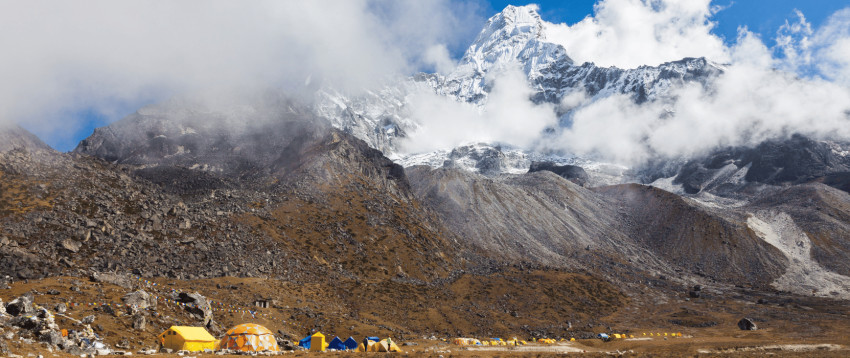
Ama Dablam is a beautiful and challenging mountain peak in the Himalayas, located in the Khumbu region of Eastern Nepal. An expedition to Ama Dablam involves climbing this iconic peak, which stands at 6,812 meters (22,349 feet) above sea level.
The expedition typically involves a mix of technical rock, ice, and snow climbing. It’s renowned for its steep ridges and challenging terrain, requiring climbers to have a good level of technical skill and experience in high-altitude mountaineering. The climb usually takes several weeks and involves acclimatization periods to adjust to the altitude.
Ama Dablam BaseCamp
Ama Dablam is often considered one of the most beautiful peaks in the Himalayas due to its distinctively shaped summit, which resembles a mother’s necklace (Ama Dablam translates to “Mother’s Necklace” in Nepali). Climbers are drawn not only to the technical challenge but also to the breathtaking views it offers of neighboring peaks like Everest, Lhotse, and Makalu.
Expeditions to Ama Dablam are typically undertaken by experienced climbers either independently or as part of guided groups, and they require careful planning, physical fitness, technical proficiency, and adherence to safety protocols due to the demanding nature of the climb and the high altitude.
Route and Difficulty:
- Southwest Ridge: The most popular and frequently climbed route.
- Technical Difficulty: Considered a technically challenging climb, involving rock, ice, and mixed climbing.
- Altitude: The peak stands at 6,812 meters (22,349 feet) above sea level.
Duration:
- Typical Expedition Length: Approximately 4 to 6 weeks, allowing for acclimatization and climbing periods.
Itinerary:
Day 01: Arrival in Kathmandu
Arrive in Kathmandu, meet the expedition team, and settle into accommodations. Briefing and introduction to the expedition.
Day 02: Sightseeing in Kathmandu and Expedition Preparation
Guided tour of Kathmandu’s cultural and historical sites. Expedition preparation, gear checks, and final arrangements.
Day 03: Lukla flight and Trek to Monjo
Take a scenic flight to Lukla and begin the trek towards Monjo. Pass through lush forests, suspension bridges, and picturesque villages along the Dudh Koshi River.
Day 04: Trek from Monjo to Namche Bazaar
Continue the trek, ascending further into the Everest region. Cross the Sagarmatha National Park entrance and reach Namche Bazaar, a bustling Sherpa town.
Day 05: Acclimatization Day — Namche
Acclimatization day at Namche Bazaar. Explore the town, visit local markets, and take short hikes to higher altitudes to aid acclimatization.
Day 06: Trek from Namche Bazaar to Tengboche
Trek towards Tengboche, passing through serene forests with occasional views of Everest and neighboring peaks. Reach the famous Tengboche Monastery.
Day 07: Trek from Tengboche to Ama Dablam Base Camp
Continue the trek towards Ama Dablam Base Camp. The trail offers stunning views of Ama Dablam and surrounding peaks as you approach the base camp.
Day 08–17: Climbing Period (Summit Ama Dablam and Back to the Base Camp)
Climbing period: Summit Ama Dablam and descend back to Base Camp. This period involves acclimatization rotations, establishing higher camps, and finally attempting the summit.
Day 18: Trek back to Tengboche
Descend from Base Camp to Tengboche. Reflect on the expedition’s achievements and enjoy the scenery during the return journey.
Day 19: Trek from Tengboche to Namche Bazaar/Monjo
Continue the descent towards Namche Bazaar or Monjo, retracing the path through familiar trails and landscapes.
Day 20: Trek from Namche Bazaar to Lukla
Descend further towards Lukla, passing through the villages and enjoying the final views of the Himalayas.
Day 21: Fly back to Kathmandu
Take a scenic flight back to Kathmandu. Relax or explore more of the city, enjoying the contrast between the bustling capital and the serene mountains.
Day 22: Final Departure
Final day in Kathmandu. Departure from Kathmandu according to your travel plans.
Preparation and Experience:
- Fitness and Training: Climbers need excellent physical fitness, endurance, and strength due to the technical nature of the climb and high altitude.
- Experience: Previous experience in high-altitude mountaineering, rock climbing, and ice climbing is highly recommended. Many climbers attempt Ama Dablam after having experience on other significant peaks.
Logistics and Support:
- Permits: Climbing permits from the Nepalese government are required.
- Guides and Support Staff: Many expeditions are guided by experienced Sherpas or mountaineering guides who assist with logistics, route planning, and support during the climb.
- Base Camp: Establishing a base camp and higher-altitude camps is part of the expedition’s logistics.
Equipment:
- Technical Gear: Climbing gear such as ropes, ice axes, crampons, helmets, harnesses, and specialized high-altitude clothing.
- Camping Equipment: Tents, sleeping bags, cooking gear, and supplies for the expedition duration.
Weather and Season:
- Climbing Season: Typically, the best times for climbing are during the spring (April-May) and autumn (late September-October) when weather conditions are more stable and visibility is better.
Challenges:
- Altitude Sickness: Acclimatization is critical to avoid altitude-related health issues.
- Weather Conditions: The weather in the Himalayas can be unpredictable and harsh, affecting climbing conditions.
- Technical Difficulty: Negotiating steep and challenging sections, including ice cliffs and rocky ridges, requires skill and caution.
Safety and Risks:
- Rescue and Evacuation: Remote location and high altitude make rescue operations challenging and time-consuming.
- Avalanche Risk: Ama Dablam’s terrain can pose avalanche hazards during certain conditions.
An Ama Dablam Expedition is a serious endeavor that demands thorough preparation, proper equipment, experienced guidance, and a high level of commitment from climbers. Safety and cautious decision-making are paramount in such a challenging climbing environment.






